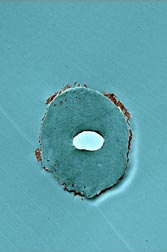Firefighters everywhere are likely to appreciate the efforts of researchers at Texas A&M University (US) to a develop a non-toxic fire retardant coating. From a February 12, 2019 news item on Nanowerk (Note: A link has been removed),
Texas A&M University researchers are developing a new kind of flame-retardant coating using renewable, nontoxic materials readily found in nature, which could provide even more effective fire protection for several widely used materials.
Dr. Jaime Grunlan, the Linda & Ralph Schmidt ’68 Professor in the J. Mike Walker ’66 Department of Mechanical Engineering at Texas A&M, led the recently published research that is featured on the cover of a recent issue of the journal Advanced Materials Interfaces (“Super Gas Barrier and Fire Resistance of Nanoplatelet/Nanofibril Multilayer Thin Films”).
Successful development and implementation of the coating could provide better fire protection to materials including upholstered furniture, textiles and insulation.
“These coatings offer the opportunity to reduce the flammability of the polyurethane foam used in a variety of furniture throughout most people’s homes,” Grunlan noted.
A February 8, 2019 Texas A&M University news release (also on EurekAlert) by Steve Kuhlmann, which originated the news item, describes the work being done in collaboration with a Swedish team in more detail,
The project is a result of an ongoing collaboration between Grunlan and a group of researchers at KTH Royal Institute of Technology in Stockholm, Sweden, led by Lars Wagberg. The group, which specializes in utilizing nanocellulose, provided Grunlan with the ingredients he needed to complement his water-based coating procedure.
In nature, both the cellulose – a component of wood and various sea creatures – and clay – a component in soil and rock formations – act as mechanical reinforcements for the structures in which they are found.
“The uniqueness in this current study lies in the use of two naturally occurring nanomaterials, clay nanoplatelets and cellulose nanofibrils,” Grunlan said. “To the best of our knowledge, these ingredients have never been used to make a heat shielding or flame-retardant coating as a multilayer thin film deposited from water.”
Among the benefits gained from using this method include the coating’s ability to create an excellent oxygen barrier to plastic films – commonly used for food packaging – and better fire protection at a lower cost than other, more toxic ingredients traditionally used flame-retardant treatments.
To test the coatings, Grunlan and his colleagues applied the flexible polyurethane foam – often used in furniture cushions – and exposed it to fire using a butane torch to determine the level of protection the compounds provided.
While uncoated polyurethane foam immediately melts when exposed to flame, the foam treated with the researchers’ coating prevented the fire from damaging any further than surface level, leaving the foam underneath undamaged.
“The nanobrick wall structure of the coating reduces the temperature experienced by the underlying foam, which delays combustion,” Grunlan said. “This coating also serves to promote insulating char formation and reduces the release of fumes that feed a fire.”
With the research completed, Grunlan said the next step for the overall flame-retardant project is to transition the methods into industry for implementation and further development.
Here’s a link to and a citation for the paper,
Super Gas Barrier and Fire Resistance of Nanoplatelet/Nanofibril Multilayer Thin Films by Shuang Qin, Maryam Ghanad Pour, Simone Lazar, Oruç Köklükaya, Joseph Gerringer, Yixuan Song, Lars Wågberg, Jaime C. Grunlan. Advanced Materials Interfaces Volume 6, Issue 2 January 23, 2019 1801424 DOI: https://doi.org/10.1002/admi.201801424 First published online: 16 November 2018
This paper is behind a paywall.
